
Linanthus maculatus is a species of flowering plant in the phlox family known by the common names San Bernardino Mountain gilia and Little San Bernardino Mountains gilia. It is endemic to California, where it is known only from a few locales in the Little San Bernardino Mountains and the adjacent Palm Springs area in the northern end of the Coachella Valley. The largest populations, which may contain thousands of individuals, are located within the bounds of Joshua Tree National Park. This is a very small annual herb no more than three centimeters high. It has a taproot which may exceed 6 centimeters in length to collect moisture from the dry desert sand in its native habitat. The tiny, hairy stem branches to form small matted clusters on the sand surface. The hairy leaves are just a few millimeters long and unlobed. The inflorescence is a dense cluster of flowers each only 2 to 5 millimeters wide. The flower corolla has curled-back lobes which are white, sometimes with a spot of purple or pink. The protruding stamens are yellow. The main threat to this species is development in its range, and it is also vulnerable to off-road vehicle damage in the wide open sandy flats where it grows.
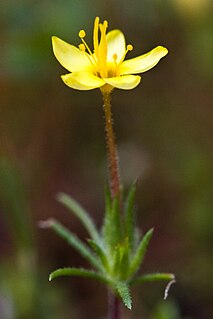
Leptosiphon acicularis is a species of flowering plant in the phlox family known by the common names bristly linanthus and bristly leptosiphon.

Leptosiphon androsaceus is a species of flowering plant in the phlox family known by the common name false babystars.
Leptosiphon bolanderi is a species of flowering plant in the phlox family known by the common name Bolander's linanthus.
Leptosiphon breviculus is a species of flowering plant in the phlox family known by the common name Mojave linanthus. It is endemic to California, where it is known from the Mojave Desert and dry spots in the adjacent Transverse Ranges.

Leptosiphon ciliatus is a species of flowering plant in the phlox family known by the common name whiskerbrush.
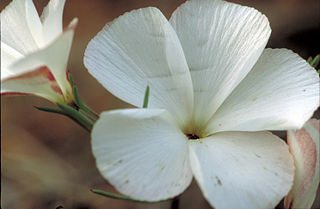
Linanthus dichotomus is a species of flowering plant in the phlox family known by the common name eveningsnow. It is native to western North America, including most of the southwestern United States, where it is a common member of the flora in a number of habitat types. It is often found on the serpentine soils of California. This is an annual herb producing several thin, waxy, erect stems up to 20 centimeters tall. The leaves are divided into linear lobes 1 or 2 centimeters long. The inflorescence produces a cyme of vespertine flowers which unroll into funnel-shaped corollas. The white lobes are just over a centimeter long and have purple shading on the undersides.
Leptosiphon filipes is a species of flowering plant in the phlox family known by the common name thread linanthus.

Leptosiphon grandiflorus is a species of flowering plant in the phlox family known by the common names large-flower linanthus and large flowered leptosiphon.
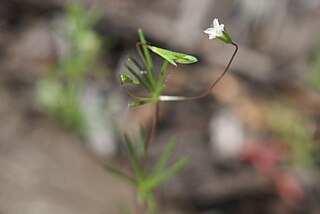
Leptosiphon harknessii is a species of flowering plant in the phlox family known by the common name Harkness' flaxflower.
Linanthus killipii, known by the common name Baldwin Lake linanthus, is a rare species of flowering plant in the phlox family.
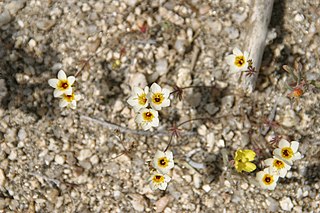
Leptosiphon lemmonii is a species of flowering plant in the phlox family known by the common name Lemmon's linanthus.

Leptosiphon montanus is a species of flowering plant in the phlox family known by the common name mustang clover.

Leptosiphon nuttallii is a species of flowering plant in the phlox family known by the common name Nuttall's linanthus.
Leptosiphon oblanceolatus is a species of flowering plant in the phlox family known by the common name Sierra Nevada linanthus.
Linanthus orcuttii is an uncommon species of flowering plant in the phlox family known by the common name Orcutt's linanthus. It is known only from southern California and Baja California, where it grows in chaparral and pine forests in the Peninsular Ranges and occasionally the San Bernardino Mountains.
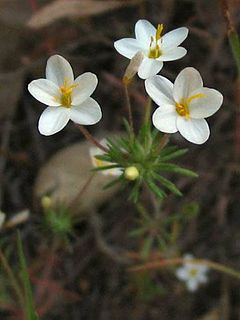
Leptosiphon parviflorus is a species of flowering plant in the phlox family known by the common name variable linanthus.

Leptosiphon rattanii is a rare species of flowering plant in the phlox family known by the common name Rattan's linanthus.
Leptosiphon serrulatus is a rare species of flowering plant in the phlox family known by the common name Madera linanthus. It is endemic to California, where it is known from the chaparral and woodlands in the Sierra Nevada foothills, from Madera to Kern Counties.
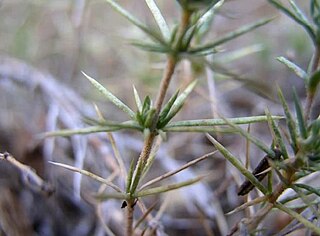
Linanthus watsonii is a species of flowering plant in the phlox family known by the common name Watson's prickly phlox. It is native to the western United States, where it occurs in Colorado, Idaho, Nevada, Utah, and Wyoming.













